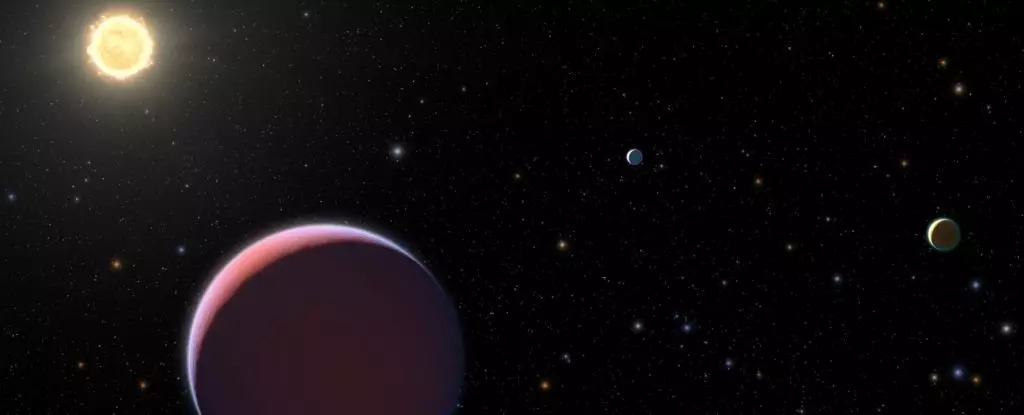Situated approximately 2,600 light-years from Earth lies the Kepler-51 planetary system, which has captivated astronomers since its discovery in 2012. The system orbits a Sun-like yellow dwarf star and was initially thought to host three exoplanets, each with astonishingly low densities—lighter than cotton candy. These celestial bodies were consequently categorized as “super-puff” planets, a term that humorously underscores their ethereal characteristics. Recent research has revealed the existence of a fourth exoplanet, sparking excitement and intrigue within the scientific community. The discovery poses new questions surrounding planetary formation and dynamics in this unique system.
Planetary scientist Jessica Libby-Roberts from Penn State expressed her astonishment, stating that super-puff planets are generally rare and that finding three such planets in a single system was already puzzling. The addition of a fourth introduces an unforeseen complexity that demands further exploration. The challenges are compounded by the possibility of additional undiscovered planets within this system, creating a tantalizing puzzle for astronomers eager to understand the intricacies of its formation.
The need for detailed observational data led to enhanced scrutiny of the three well-documented exoplanets in 2019. Using advanced methods to assess radii and masses, researchers were able to deduce their unusually low densities, confirming their classification as super-puffs. However, the quest to capture one of these exoplanets during its transit—a time when the planet crosses in front of its host star—turned unexpectedly convoluted, leading researchers to suspect that the dynamics influencing these celestial bodies were far more complicated than initially presumed.
In an attempt to observe a transit, astronomers employed both the Apache Point Observatory (APO) and the James Webb Space Telescope (JWST). Yet, circumstances deviated from their expectations as they attempted to monitor a scheduled transit. Libby-Roberts recounted the tension of waiting past their anticipated time for observations, followed by frantic recalibrations of their models. A sudden, unanticipated dip in stellar brightness provided the first clue that something was critically amiss—indicating a previously undetected fourth planet may be at play.
Confronted with this unexpected revelation, the research team dove into extensive data analysis. They used information gathered from NASA’s TESS spacecraft alongside historic observations from various ground-based observatories like Hubble and Palomar. The conclusion emerged that a fourth exoplanet, referred to as Kepler-51e, was responsible for the gravitational perturbations affecting the known exoplanets’ transit timings, a compelling indicator that this new discovery might not be an ordinary occurrence.
While precise measurements of Kepler-51e remain elusive since it has yet to be observed transiting, researchers hypothesize that it shares a mass similar to that of its neighboring planets. It is suggested that this exoplanet orbits the star in around 264 days, following a nearly circular trajectory, a pattern seen across other planetary systems. However, alternative models indicate that it could also be more massive and located on a wider orbit, though less probable.
One fundamental question persists: how does the presence of this fourth planet influence the existing celestial ballet of the Kepler-51 system? Its unique status raises intriguing questions about orbital mechanics and the forces that govern the relationships between planets in a shared gravitational well. Furthermore, as astronomers continue to sift through observational data, they are also working on uncovering the atmospheric compositions of the known super-puff exoplanets, which could yield critical insights into their origins and structural characteristics.
The Path Ahead: Observation and Analysis
Understanding the Kepler-51 system requires ongoing observation and analysis. Future studies will aim to probe the atmospheres of these super-puff exoplanets, helping to paint a clearer picture of their formation and evolution. The inherent strangeness of a planetary system containing multiple super-puff planets invites a profound re-examination of existing theories about planet formation.
The Kepler-51 discovery not only raises questions about the planets themselves but also invites broader reflections on the diversity of planetary systems across the universe. With advances in technology and continuous observational efforts, astronomers are poised to unlock more of the secrets contained within this beguiling cosmic ensemble, propelling our understanding of the complexities of planetary formation toward new horizons. As the exploration continues, the peculiarities of Kepler-51 stand as a testament to the ever-expanding frontier of astronomical discovery.

